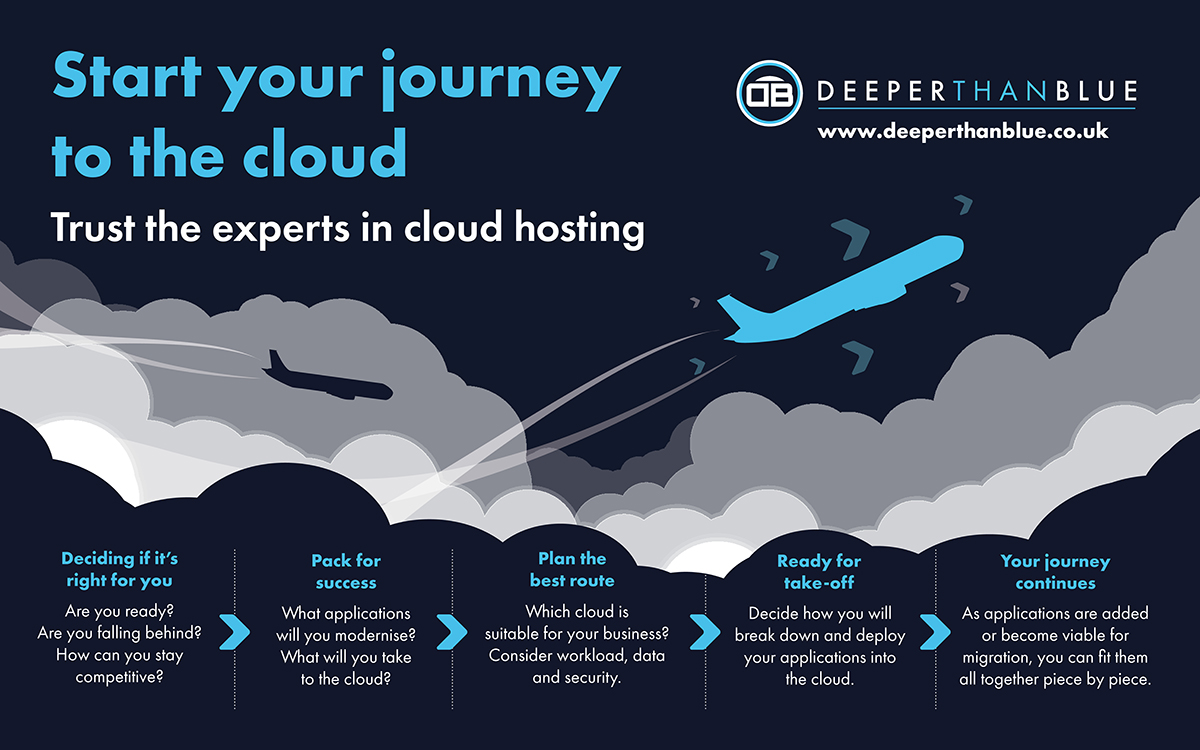 Steve Pownall
| 29 February 2024 |
Steve Pownall
| 29 February 2024 |
Embark on your journey to the cloud in 2024

Modernising your technology by moving applications into the cloud is not a new concept. In this day and age, it’s pretty common. But what does migration to the cloud entail? How long does it take? Do you need to become fully cloud-based? Is it even right for you?
We’ve put together this handy guide to starting your cloud journey, what to expect and where to start so that you can plan your strategy.
Is it necessary?
In today’s business landscape, there is one constant your business can rely on: change. The IT requirements your business use at present are bound to undergo transformations within months, if not weeks. That’s how quickly things change in this sphere. As businesses continue to expand and venture into new territories, constantly improving and disrupting industries through pioneering digital technologies, it becomes evident that your IT needs will evolve accordingly.
In today’s climate, modern infrastructure is the foundation for a successful organisation. By providing the capability to swiftly create secure and scalable applications, it empowers businesses to foster innovation and be able to support new products and services or transform business processes. Updating business infrastructure helps businesses to collaborate more effectively, both internally and externally, by providing secure web-based and mobile access to shared data and apps, from any place, at any time.
In our opinion, migrating to the cloud is an obvious path, enabling you to modernise and future-proof your IT stack.
Step 1: Pack for success. And pack light.
As with any journey, deciding what to take with you is critical. Early adopters of digital transformation methods employed a basic ‘lift and shift’ approach, choosing to migrate lighter workloads in their entirety to the cloud, whilst keeping some of their larger legacy pieces on-premise.
Unfortunately, this has led them away from discovering the truly creative, operational and financial benefits of cloud migration. Generally, enterprises at this stage of their journey will manage to migrate 20% of their workloads to the cloud, leaving the remaining 80% still requiring modernisation; contrary to their belief that they’re ahead of the curve, they’re actually behind it.
So, how do you plan a more conclusive journey to the cloud from the outset? By analysing all business workloads and initially prioritising those which would benefit from modernisation and by breaking down applications into microservices and deploying to the cloud in smaller, more agile clusters, your business will quickly start to see the value of cloud computing. And of course, as experts in cloud migration, we can help you choose what stays at home and what comes with you on your trip.
Step 2: Plan the best route for you.
Now that you’ve decided what to pack on your journey, planning which route to take is the next step, avoiding routes with known congestion or which are unsuitable for your chosen vehicle.
There are three options to choose from when deploying workloads to the cloud:
- Private Cloud is cloud infrastructure reserved solely for a single organisation, whether managed internally or by a third party and hosted either internally or externally. A private cloud can often provide greater levels of security, where the data sits behind enterprise firewalls.
- Public Cloud is where the infrastructure sits in a network that is open for public use. There is little to no difference between public and private cloud architecture, save for security considerations you’ll have to make depending on what kind of data you’re migrating. We work with some of the biggest cloud platforms, or hyperscalers, including Google Cloud, Microsoft Azure and Amazon AWS.
- Hybrid Cloud is a composition of two or more clouds (private or public) that remain distinct entities but are integrated together, offering the benefits of multiple deployment models.
It can be difficult to land on a final decision at this stage, and we can help with this. We consider the size of the workload you’re migrating, the nature of your data and subsequent security needs, your operational requirements and suggest the destination and provider you should go with.
Step 3: Leaving the runway
Once you have a solid plan for migration, your journey to the cloud can start to move.
Microservices
Breaking down your applications into microservices gives you the flexibility to architect your applications as you like them, provides greater possibilities where scalability is concerned and enables continuous delivery without disruption.
Adopt a DevOps approach
By baking in governance standards into your infrastructure before deploying applications into it, you’re ensuring the application’s delivery is high quality and giving yourself peace of mind that security will stay efficient and repeatable.
Test often and deploy quickly
The above allows a business team to learn and iterate at pace, developing a minimum viable product. This can vary in shape and size for organisations especially when replacing or re-inventing an existing application. The key here is small iterations that quickly build the replacement.
Step 4: In flight
Typically, you’ll have a number of things to consider when choosing which workloads to move to the cloud, and this doesn’t begin and end at step one. For a variety of reasons, such as software age, longevity of a workload, or complex data interdependencies, some workloads may never move to the cloud and will remain in a traditional IT environment. However, many existing workloads are viable candidates for moving to the cloud—or may become one in the future—and, of course, brand-new applications are most likely born on the cloud from the start.
Summary
The question, then, is no longer why you should journey to the cloud, but under what circumstances, what is right for you and how to approach it piece by piece.
Selecting the right applications to be your ‘pioneers’ and identifying the best migration or modernisation path for each requires an analysis of workloads, business needs, and technical complexities. It’s not easy. But when done right, it can deliver all the benefits of maximised efficiency, increased agility and greater freedom to innovate that you set out to deliver for your business.
As always, we’re here to help. We’re experts in complex migrations and are familiar with the plethora of moving parts within a business’ infrastructure. We understand the nuances and our attention to detail is unmatched. If you’re looking for help on your journey, reach out to us below and we’ll help you on your way.
Related Content
IBM Cloud Paks – a strategy for organisations looking to move their workloads to the Cloud
What does it mean to take existing legacy systems and re-engineer them to the cloud to make companies faster andFind out more
Our top four Cloud providers of 2023: How each could benefit your business
At DeeperThanBlue, we’ve been banging the cloud computing drum for years. We help our clients enhance business efficiencies, enjoy costFind out more
These might interest you
IBM Cloud Paks – a strategy for organisations looking to move their workloads to the Cloud
What does it mean to take existing legacy systems and re-engineer them to the cloud to make companies faster and Read MoreOur top four Cloud providers of 2023: How each could benefit your business
At DeeperThanBlue, we’ve been banging the cloud computing drum for years. We help our clients enhance business efficiencies, enjoy cost Read MoreIf you are interested in excelling in your market, becoming a digital disruptor or simply finding out more please get in touch.
+44 (0)114 399 2820

